René MAILLARD
1931 - 2012
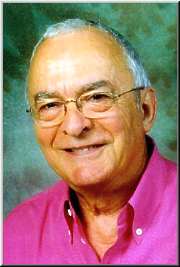 |
| René Maillard ( Studio Beaumont, Nice, 2002, coll. René Maillard ) |
Shortly after winning his Prix de Rome, the confrontation with the realities of life quickly got the better of this young composer’s ‘great expectations’. The independence, both material and philosophical, that he had always demonstrated obliged this artist to change direction and enter ‘civilian life’, which allows for ensuring material well-being for want of consecration. And yet, the few works that he had had the time to write showed that this musician was in full possession of his art. Belonging to no coterie, he gave expression to his profound sensitivity and natural imagination. His Concerto da Camera, written in 1953 and given its first public performance at the Ecole Normale de Musique in Paris on 21 May 1954, by Bernard Wahl conducting the Versailles Chamber Orchestra, met with a certain success at the time; here he had composed a sincere, direct work, intended for an almost-popular audience. After a fermata lasting more than 40 years (!), it was at the beginning of the new millennium that René Maillard came back to composition….
Born 8 April 1931 in Bois-Colombes, on the outskirts of Paris, René Maillard carried out his secondary studies at the Collège Gay-Lussac in Limoges, during the Second World War. He perfectly remembers his very first violin teacher in that city, Charles Paillier, whom he continues to hold in high esteem. He went on to become a student of Arthur Hoérée1 (1897-1986), professor of composition at the Ecole Normale de Musique and friend of Albert Roussel and Arthur Honegger, whom he described as a ‘brilliant character’. He also attended the Versailles Conservatory, where he benefited from the teaching of Aimé Steck (winner of the Prix de Rome in 1922) in his writing class, before entering the Paris Conservatoire. There, he studied harmony, counterpoint and fugue with Samuel-Rousseau and Noël Gallon, obtaining his first prizes before enrolling in Tony Aubin’s composition class. In 1955, he competed for the Prix de Rome with Le rire de Gargantua, a lyric scene on a libretto by Randal Lemoine based on Rabelais. Performed on 28th June 1955 by the Orchestra of the Opéra-Comique under the direction of Jean Fournet, with soloists René Bianco, Louis Rialland and Jacqueline Cauchard, it received a Second Grand Prix.
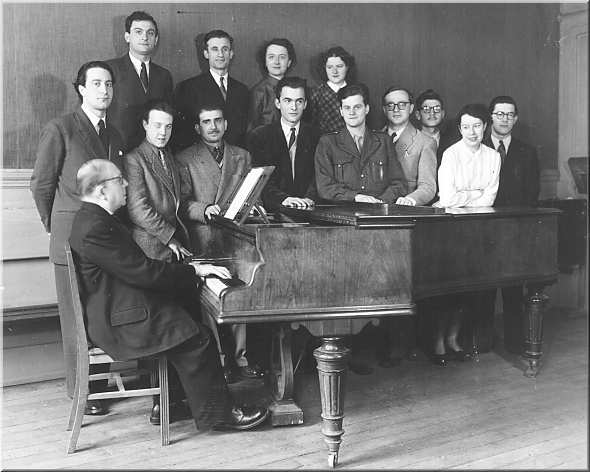 |
| Classe de contrepoint et de fugue de Noël Gallon au Conservatoire National Supérieur de Musique de Paris en 1952. Parmi les 13 élèves, 1er rang de gauche à droite: X..., Jean-Pierre Rivière, Alphonse Autran, René Maillard, Raphaël Beaufort (en uniforme), Cyril Squire, Roger Hugon, Sylviane Lancel, Pierre Bauzin. 2ème rang, de gauche à droite: Moïse Franco, X..., X..., Pierrette Mari. ( Photo Jean Hames, Neufchâtel-en-Bray, coll. René Maillard ) |
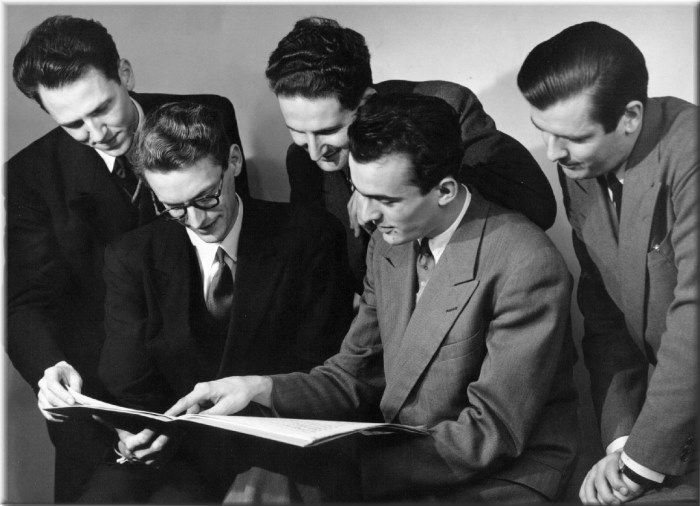 |
| Le groupe "Pentacorde" vers 1953. De gauche à droite : Jacques Boisgallais (debout), Pierre Doury (assis), Bernard Wahl (debout), René Maillard (assis), Clermont Pépin (debout) ( photo Louis Jacob, portraitiste, 3 rue de Nogent, Saint-Cloud ; coll. René Maillard, avec son aimable autorisation ) |
It is from this period that dates René Maillard’s Concerto da Camera No. 1, one of his major works, which he would also subsequently revise in 2010. Composed in two months during the summer of 1953, this piece, for strings alone, was conceived in the spirit of the concerto grosso, with an important part for the orchestra’s solo instruments. It consists of three movements: a Moderato, written in sonata form with two themes; an Andante non troppo, using a single theme presented by the soloists then taken up by the various sections of the orchestra; and finally, an Allegro with a main subject and, in the background, allusions to folklore. Given at the Radio on 4th May 1954 by the Armand Belai Chamber Orchestra, then by that of Gérard Devos, this Concerto was next performed at the Ecole Normale de Musique on 21st May, then by Louis de Froment conducting the ORTF Chamber Orchestra on 23rd December 1956, and later on (15th May 1958) by the Orchestra of Nice. The year 1956 would be particularly rich on the creative level, with a String Trio (revised in 2005), a song, Le Rouge-gorge, on a poem by Paul Fort, a Serenade for wind quintet and a lyric scene for soprano, tenor, baritone and orchestra on a libretto by Charles Clerc after Molière: Le mariage forcé, premiered at the Paris Opera on 27 June 1956.
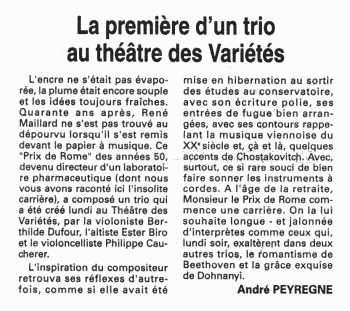 |
| Compte-rendu concert du 21 février 2005 au Théâtre des Variétés de Monaco, création du Trio à cordes de René Maillard ( André Peyregne, Nice-Matin, février 2005 ) |
In 1957, René Maillard joined EMI as artistic director. For three years he was, in a way, the ‘façonnier’ or shaper (to use his term) of great artists such as Samson François, Paul Tortelier or even Villa-Lobos. But this type of work, ‘at the service’ of millionaires of the recording industry, hardly corresponded to his aspirations; in addition, the job did not pay well and left him not a moment’s respite for composing. Greatly vexed and increasingly running up against an institutional system discouraging young composers from performing, René Maillard resigned from EMI, gave up any thought of a musical career and resolved to pursue his professional life in a completely different field. So it was that he was recruited as a senior executive by an important American pharmaceutical laboratory (later absorbed by Laboratoires Roche) where, in particular, he ran the sales and training sectors. Shortly before abandoning music with regret, he nonetheless composed an orchestral work entitled Tre partite attaccate (later renamed Concerto da Camera No. 2), first performed by Serge Baudo at the Aix-en-Provence Festival on 23 July 1960, and above all, for obvious reasons, a Contre Pas for wind quintet and string orchestra (revised in 2003 with the addition of a finale, Allegro-presto, and renamed Concerto grosso). Commissioned in 1961 by the State, it was not performed at the time for lack of money for the orchestral parts! It would be nearly a half-century before it was finally played and recorded (2009)… He also wrote a few other works in the 1950s or ’60s, in particular a three-part Suite sur des thèmes populaires for orchestra (1958-59), Le Nid à cousins, La Danse des Farfadets (commissioned by the French Radio, ORTF, and published by Sofirad), Pour la fête du Printemps (ORTF, Paul Bonneau) and light music (Editions Salvet), recorded by EMI and Barclay.
Subsequently, once he had retired and settled on the Côte d’Azur where, in the mildness of the climate, he gave himself over to his lifelong passions, golf and bridge, René Maillard, after a hiatus of more than forty years, returned to composition at the beginning of the millennium, at the urging of Nicolas Bacri. So it was that he produced a second sonata for viola and piano for the duo Arnaud Thorette-Johan Farjot, a Petite Suite for two double basses, a string quartet premiered on 2nd February 2005 by the Ensemble Syntonia, and proceeded to the revision of his String Trio at the request of the ‘Soloists de Cannes’ Trio (Berthilde Dufour, Eszter Biro, Philippe Cauchefer), who gave the first performance on 21st February 2005 at the Théâtre des Variétés in Monaco. In late 2003, Nicolas Bacri asked him to join the composers’ association that he had just founded, ‘Cantus Formus’. It was in the course of one of this group’s concerts, on 13th October 2004 in Paris, that his Viola Sonata No. 2 was premiered. Since then, the taste for composition has continued to occupy him and it is with pleasure that we owe him several additional opuses, including three pieces for organ: Sonata (2007), Toccata (2008) and Hymn to Saint Denis (2010); three pieces of chamber music: Nocturne for cello and piano (2005), Sonate en duo for violins (2005, recorded by Triton) and Prélude, aria et fugue for cello and organ (2007); two pieces for solo piano: a Toccata (2009) and Poèmes (2010); vocal works: Cinq mélodies on erotic poems by Jean-Marc Stricker (2006, first performed in April 2006 at the Péniche Opéra) and Fébrilité, a cycle of three songs on poems by Dominique Pagnier (2008), as well as a cantata for mezzo-soprano, chorus and orchestra, on a poem by Monique Charles based on the true story of Kyoko Hama, entitled Survivre après Hiroshima (2006-07). Subtitled ‘A message of hope’, this veritable hymn to life and song of hope is a striking, profoundly human work in which are found all the composer’s qualities: sensitivity, clarity of discourse, the rich orchestral palette, timeless writing, classic but abounding in new ideas. In it one hears the continuity of the French musical tradition as represented by d'Indy, Dukas, Ravel and Florent Schmitt. The published works are to be found at Le Chant du Monde or Delatour France.
Denis Havard de la Montagne
Translated by John Tyler Tuttle
____________
1) Né le 16 avril 1897 à Gilles (près de Bruxelles), décédé le 3 juin 1986 à Paris, Arthur Hoérée, professeur de composition à l'E .N .M. à partir de 1950, est surtout connu comme musicologue. Il a notamment contribué au Dictionnaire de la musique de Marc Honegger (Bordas, 1970) et a longtemps été attaché à l'ORTF à des titres divers. Ami d'Albert Roussel, auquel il a consacré deux monographies, et surtout d'Arthur Honegger, il a collaboré avec ce dernier à l'élaboration et l'orchestration de plusieurs musiques de film. Comme compositeur, on lui doit de la musique de chambre et instrumentale, quelques pages pour orchestre et surtout de la musique pour la scène, notamment un conte lyrique, Crève-Cœur le magicien (1961), et 40 musiques de films longs et courts-métrages. [ Retour ]
2) Le " Groupe Pentacorde ", qui vit le jour au début des années cinquante, était composé de cinq jeunes compositeurs d'esthétiques diverses : René Maillard, Pierre Doury, Jacques Boisgallais, les deux premiers habitant Versailles, Bernard Wahl, domicilié à Sèvres et dirigeant l'Orchestre de chambre de Versailles, et le Canadien Clermont Pépin, alors résidant à Vincennes et venu en France pour achever ses études de composition. [ Retour ]
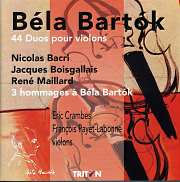 |
Paru en 2006 : Bela Bartok, 44 Duos pour violons et 3 hommages Eric Crambes, François Payet-Labonne, violons 44 Duos pour violons, Bela Bartok Sonata in memoriam Bela Bartok pour deux violons, op. 96, Nicolas Bacri Jeu de modes pour deux violons, Jacques Boisgallais Sonate en duo pour deux violons, op. 22-a, René Maillard 1 CD Triton, TRI 331145, www.disques-triton.com |
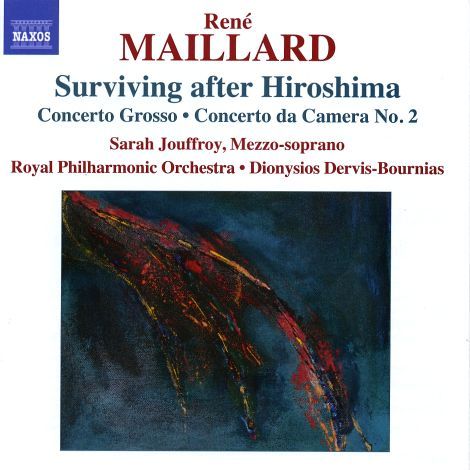 Un disque qui présente trois superbes compositions de René Maillard (°1931), compositeur français, lauréat du Prix de Rome en 1955, symbolisant parfaitement la fructueuse symbiose entre tradition et modernité, revenu, au début des années 2000, à la composition sur les conseils éclairés de Nicolas Bacri, après une interruption de plus de quarante ans. Surviving after Hiroshima est une cantate pour mezzo-soprano, chœur & orchestre, inspirée de l'histoire vraie de Kyoko Hama, véritable hymne à l'espoir mettant en avant toutes les qualités du compositeur, écriture intemporelle, clarté et richesse des couleurs orchestrales. En reprenant les formes classiques et traditionnelles, revisitées, le Concerto grosso pour quintette à vents & orchestre à cordes, composé en 1961, révisé en 2003 et le Concerto da Camera n°2 pour orchestre à cordes, composé en 1959, complètent ce magnifique enregistrement. Absolument indispensable ! Patrice Imbaud
in L'Education musicale Lettre d'information, n° 53, nov. 2011 |
Paru en 2011 : René Maillard Surviving after Hiroshima, cantate pour mezzo-soprano solo, quatuor vocal et orchestre, op. 24 Concerto grosso pour quintette à vent et orchestre à cordes, op. 17 Concerta da camera n° 2 pour orchestre à cordes, op. 16 Sarah Jouffroy (mezzo-soprano) Royal Philharmonic Orchestra Direction : Dionysios Dervis-Bournias Enregistrement : mars 2009 au Cadogan Hall de Londres Notice français, anglais, japonais CD Naxos 8.572623 Survivre après Hiroshima : Un message d'espoir La cantate narre l'histoire poignante de Kyoko Hama, âgée de 20 ans en 1945 fuyant Osaka et la destruction de ses bâtiments pour aller se réfugier chez des parents à Hiroshima. Elle n'échappera pas à l'atrocité causée par l'explosion de la première bombe atomique ne devant la vie sauve qu'à l'abri précaire qui la protégera de la pluie mortelle. Hymne à la vie, cette cantate est un chant d'espoir : survivre contre la haine et la guerre dans le monde des hommes enfin réunis. Kyoko vit à Osaka où sa fille enseigne la philosophie. Elle-même donne actuellement des conférences sur son passé, conférences qui ont fait l'objet d'articles élogieux dans la grande presse japonaise. Concerto Grosso pour quintette à vents et orchestre à cordes Respectant la tradition, le Concerto Grosso adopte une forme orchestrale divisée en deux groupes : d'un côté les solistes ou « Concertino », de l'autre la masse orchestrale « Ripieno » ou « Grosso ». Au cours des ler et 5ème mouvements le groupe soliste sera en dialogue constant avec l'orchestre à cordes. Au 2ème mouvement : Tema con Variazioni, les interventions individuelles vont s'échelonner, chaque soliste rivalisant de brio jusqu'au « bouquet final » en traits fulgurants de la 5ème variation. L'œuvre s'achève par un mouvement rapide dont les thèmes sont des projections de ceux déjà exposés précédemment amenant une conclusion Majestueuse en forme d'hymne. Concerto da Camera N° 2 pour orchestre à cordes Le Concerto da Camera N° 2 se présente comme un divertimento de forme classique laissant une large place aux solistes de l'orchestre. Après l'exposé des thèmes principaux, ceux-ci auront pour rôle de présenter tour à tour des thèmes secondaires souvent inspirés du folklore ensuite repris par l'ensemble de l'orchestre ; le dernier mouvement commence par une fugue au rythme incisif et s'achève par un rappel des thèmes principaux avec l'adjonction d'une trompette ad libitum. Création au Festival d'Aix-en-Provence 1960 sous la direction de Serge Baudo. |
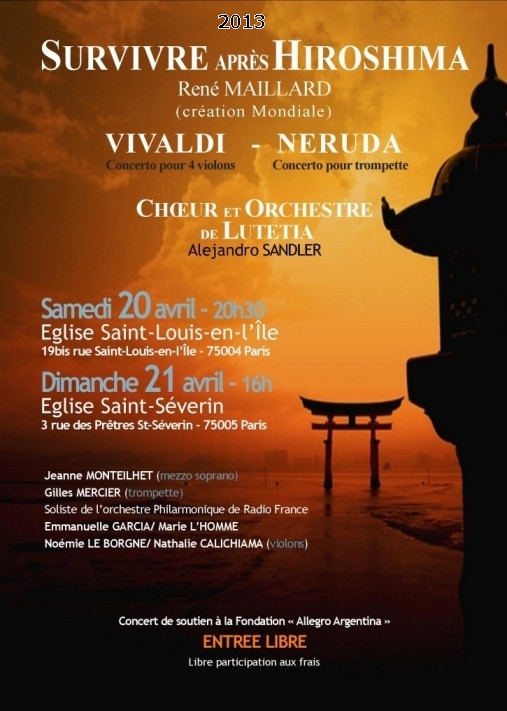
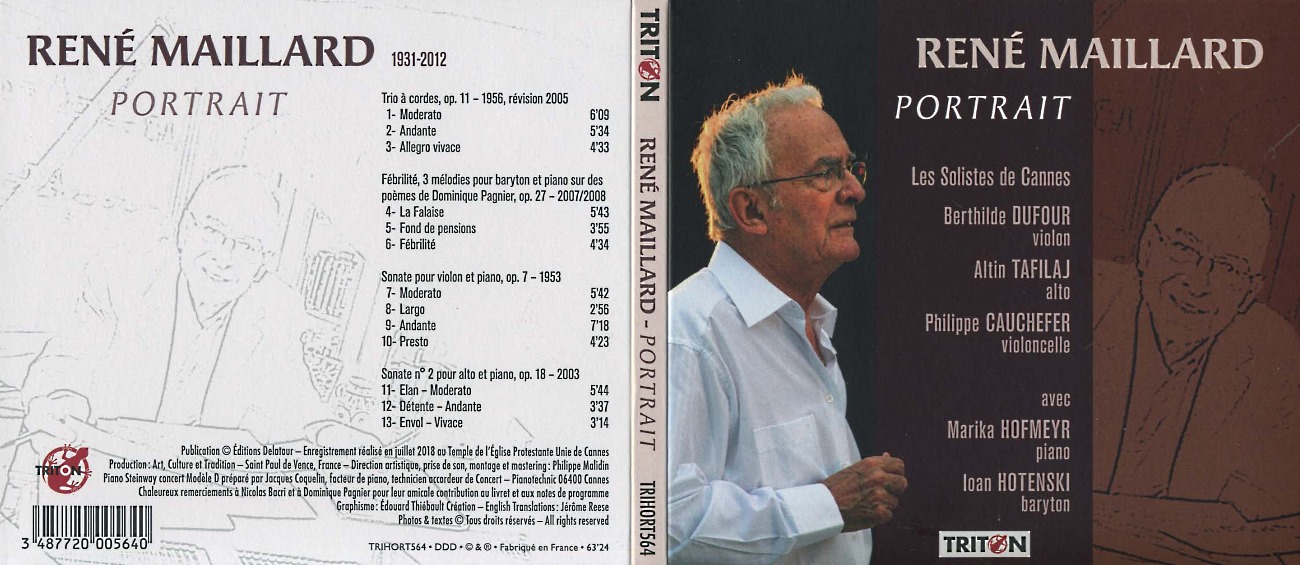 |
| René Maillard, Portrait par Les Solistes de Cannes, Marika Hofmeyer et Ioan Hotenski. Enregistrement réalisé en juillet 2018 à Cannes. Production : "Art, Culture et Tradition", Saint-Paul-de-Vence. Parution : mars 2019. CD Triton TRIHORT564. |
Catalogue des œuvres de René Maillard
